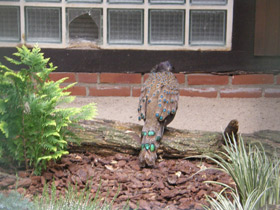The Malayan peacock-pheasant Polyplectron malacense
The Malayan peacock-pheasant, also known as crested peacock-pheasant, is endemic to the Peninsular Malaysia, inhabiting almost exclusively moist deciduous forests of the Isthmus of Kra. In the past, the Malayan peacock-pheasant was widely distributed in Malaysia and Thailand, but later its populations declined dramatically, and it disappeared from many parts of its former range. The Malayan peacock-pheasant is evaluated as vulnerable species in the IUCN Red List of Threatened Species.
The Malayan peacock-pheasant is one of the shortest-tailed peacock-pheasants. Adult males are about 50 cm long, with almost half of the length made up by the tail. The weight of the males ranges from 600 to 700 grams. The tarsus measures approximately 6.5 cm, and the wings are 20–21 cm long. The plumage of these pheasants is generally pale brown with small black spots and bands, creating the "salt-and-pepper" effect found in most peacock-pheasants. It has iridescent blue-green ocelli with a buff border on the upper wings, back, and on the 22 rectrices. A bare facial skin surrounds the eyes with the bluish-white iris. The bill and legs are blackish. The female is slightly smaller than the male, with a noticeably shorter tail. The female measures about 40 cm in overall, with the tail being almost 20 cm long. Adult females weigh about 450–550 g. The females’ plumage is duller than that of the males.
This species is not studied so well as other pheasants. While captive Malayan peacock-pheasants may sometimes appear to be polygynous, this is not typical as most peacock-pheasants are monogamous. The breeding season is not well understood; recently used nests have been found in March, April, and August. Males scrape the debris and leaf litter off their display sites in forest clearings, from where they maintain vocal contact with the females. They adopt various highly stereotyped and ritualised postures and associated plumage displays, which reveal prominent ocelli on primary feathers and rectrices.
The nest consisting of twigs and leaves is built on the ground, and the female lays a single egg. Incubation period is 22–23 days.
















































